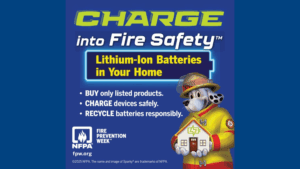Just over a year ago, seven families lost their homes and possessions in a catastrophic fire at the Highland Nanuet Apartments complex. Authorities were quickly alerted and firefighters were on the scene within minutes, but a massive fire had already erupted in one of the buildings by the time they arrived. Efforts to get the already advanced fire under control were further hindered by the lightweight construction of the building, preventing the firefighters from being able to operate inside the structure. Within minutes, the seven families had lost nearly everything they owned. It was an extremely tragic and disturbing sight to see. Unfortunately, it was far from the first time I have been on the scene of a residential fire in my years as Town Supervisor.
With that tragedy still resonating in the town, I am reminded even more strongly than usual of the importance of promoting National Fire Prevention Week as a method to help educate our residents on the steps they can take to help protect their lives and their homes. Running from October 5-11, this year’s main theme for the week is the importance of the proper use, charging, and recycling of lithium-ion batteries. These commonly used batteries can be found in just about every room in the average home. If you own a cell phone, a smart watch, a laptop, or a cordless vacuum cleaner or power tool, then you also own a lithium battery.
It makes perfect sense why these batteries have become so commonplace: they pack a lot of power into a very small physical space. It also makes perfect sense as to why using, charging, and recycling them properly is crucial: the heat they generate, combined with the volatile components in their composition, create an elevated risk of fire as a byproduct of all that power packed into a very small physical space. The good news is that these batteries are generally very safe when used and handled properly, but it’s important to know and follow four key best-practice guidelines to keep them that way.
- BUY ONLY LISTED PRODUCTS: When buying a product that uses a lithium-ion battery look for a safety certification mark such as UL, ETL, or CSA.
- CHARGE DEVICES SAFELY: Always use the cables that came with the product to charge. Follow the instructions from the manufacturer. Buy new chargers from the manufacturer or one that the manufacturer has approved. Charge your device on a hard surface. Don’t overcharge your device. Unplug it or remove the battery once it’s fully charged.
- RECYCLE RESPONSIBLY: Do not throw lithium-ion batteries in the trash or regular recycling bin. Recycle your devices or batteries at a safe battery recycling location. Visit rocklandgreen.com to find a recycling spot near you.
- STOP: Discontinue using or charging your device right away if the battery smells weird, gets too hot, makes popping noises, or changes in shape or color. Move the device away from anything that can catch fire. Call 911 if necessary.
Following these basic guidelines is an important part of overall fire safety in the home. But above all else, please remember that the best overall protection you have from being harmed or killed by a fire in the home is the proper use of smoke alarms. An alarm should be placed inside each bedroom with another outside in the hallway. At a minimum, each floor without a sleeping area (including the basement) should have one smoke detector installed. Avoid placing the detectors next to windows or doors where drafts might reduce their effectiveness, and avoid placing them within ten feet of cooking appliances to reduce false alarms. Only buy alarms that are tested and labeled by an independent laboratory agency such as Underwriters Laboratories (UL) or Intertek. Test the batteries at least monthly and replace the alarms in accordance with their published operating lifespan- typically 10 years on current models.
Proper placement and use of smoke alarms can reduce your chances of surviving a house fire by 55%. When you consider that there are approximately 350,000 reported fires in residential homes each year, representing one taking place every 87 seconds, it is easy to see just how important this can be.
In addition to advice on lithium-ion batteries and smoke alarms, more home safety tips can be found on the National Fire Prevention Association website.
Every year, Fire Prevention Week serves as an essential reminder that fire safety is something we all need to take seriously. In the event of a fire, every second matters— so, be prepared!
I also want to take this time to thank all our volunteer firefighters for their dedication and commitment to serving our community. If you are interested in volunteering, or know someone who may be, please reach out to your local department today.






